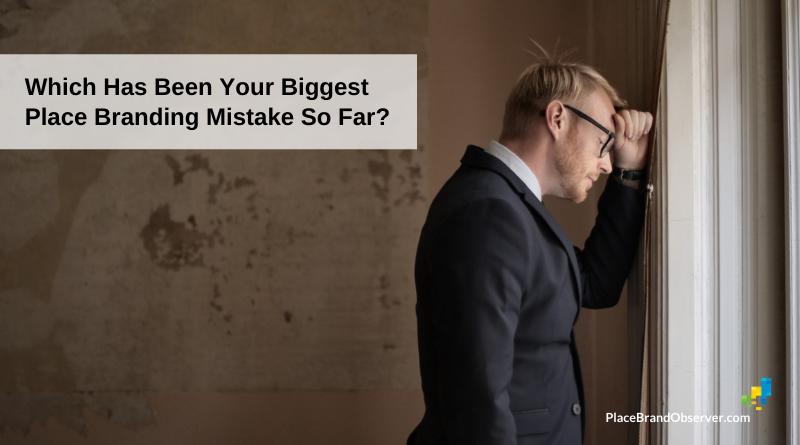In our latest panel session, we wanted to know from the world’s leading place brand experts what mistakes they have made in connection with place branding practice. Place branding being all about delivering and communicating successes, this is can be a delicate question. Sincere thanks to the panel members who shared their experiences. We can all learn from mistakes and should thus celebrate them as much as we celebrate success.
If you’d like to join this honest conversation about things that did not go too well in your own place branding endeavours (so others can avoid repeating the same mistakes), please share in the comment section below. We will reward best answers with a free one-year TPBO Premium subscription.
Below the answers (in alphabetical order – highlighted respondents are available for consulting, research, or as speakers).
Andrew Hoyne
Australia | My biggest learning experience when it comes to place branding was working on Parramatta Square. I was drinking Kool-Aid and got sucked in by my hype. We were talking about experiences, amenity, and activation as if it were coming soon. However, eight years later, it is still a construction site with many years to go. So I assume that people have lost faith as the brand turned out to be just words and pictures of something that was too far away from what real people were seeking.
So the lesson was: talk about the process more, don’t hide the timeline, and save the excitement for a time which is closer to launch
Christopher Hire
Australia | Ah well…waiting too long to seize an opportunity and to rely on data.
Should have gone more with instinct (although sometimes you can jump too soon).
Ed Burghard
USA | Assuming clients had a fundamental understanding of branding. I quickly learned that when you discussed branding, clients thought about advertising/promotion, or logo/tag line.
As a consequence, I now start every client engagement with a briefing on what branding is and an assessment of how open the client is to revisiting their place strategic plan. Branding drives strategy. If the location is not interested in making changes to their strategic plan, I advise the leadership to hire an advertising agency rather than me.
Günter Soydanbay
Soydanbay Consulting / Speaker
Canada | Fortunately, none of the projects in which I was involved was stillborn. That said, none of them realised their true potential, which points to a systemic problem – lack of engagement.
That problem could present itself in two forms: lack of stakeholder engagement during the strategy phase and lack of citizen engagement during the implementation phase.
People don’t like it and they don’t accept it when you create a brand ‘for them’. Instead, they demand to co-create it with you or at least they want to have the illusion of that. Looking backwards, that’s one area I should have harped on in my past projects.
Jeannette Hanna
Trajectory Brand Consultants / Speaker profile
Canada | I had to learn the hard way not to underestimate how politicised some projects can become. Branding initiatives can be lightning rods for power plays – by developers, levels of government competing with each other, or a host of other actors with their agendas. It’s important to build coalitions and work with leaders who bring credibility and legitimacy to the process.
Juan Carlos Belloso
Spain | I think, probably, my biggest mistakes have been:
- Not understanding enough local cultures, differences, and practices. Also, trying to adopt solutions or approaches that have worked in other places but may not work in a specific place.
- Not understanding what the ‘real or hidden’ objectives behind a place branding exercise are, many times linked to specific individual interests or political agendas.
Natasha Grand
UK | I think the principal peril in place branding is ignoring influential groups or even individuals on the ground. This goes beyond ‘stakeholder engagement’ workshops.
In one of our early projects with a national capital, we focused on the active core citizens of the city, thinking that the inert recent newcomers from the country did not affect its nature. As a result, our work expressed the personality of the city as such but not as the national capital. At the time – although it has changed since – the national capital role was more prevalent for the majority of city residents.
Since then, we thoroughly map out all groups of interests and sub-cultures of a place to ensure brand identity gives voices to them all.
Todd Babiak
Australia | When I looked at what didn’t work, in cities and states, it always seemed to be top-down, administrative, corporate-seeming, agency-driven campaigns that felt vanilla, safe, undifferentiated, and irrelevant to citizens.
So I tended to privilege community ownership, in place branding, over government ownership. My instinct was to leave the government out of it, as much as possible, at least in the early stages – and encourage community action. This fails in later phases because if the public service doesn’t feel a sense of ownership over the brand they will ignore it, fight against it, and ultimately destroy it.
Tom Buncle
Yellow Railroad Consulting / Speaker profile
UK | Bidding too low and too high – offering a Ferrari, when the client only wanted a Lada (but didn’t specify this in the tender brief), and vice versa.
Bill Geist
USA | The biggest mistake, outside of the lack of an obligatory community inclusion component that seems to trip up so many processes, is in the roll-out. While those behind the effort are rightfully proud of their work and excited to share it with the world, we counsel our clients to tell no one.
Launching a brand is one thing. Attempting to acquire praise from locals is another. We’ve seen exceptionally well-executed brands die on the shore of public opinion. Everybody thinks they are a marketing expert. Thus, after announcing a brand, the amateurs attack and deride the results in online forums placing those behind the effort in the crosshairs.
Our advice is to tell no one. As hard as it is to curb your enthusiasm, soft-launch your brand. Just start using it. And then, next year, hold a news conference to tout the results. A brand without statistics is an orphan. A brand with statistics can’t be challenged.
Inga Hlin Palsdottir
Iceland | My biggest mistake and something that has influenced the way I work since then are that in the first year of Inspired by Iceland, we did not communicate very well to our stakeholders. We did communicate when we felt like it through the first year but it was not structured, and our stakeholders were confused.
After that, I focused on communicating with the stakeholders. In my opinion, the success of the Inspired by Iceland campaign lies a lot in the cooperation and stakeholder engagement, and that structured and well-planned communications were vital, be it in regular meetings, newsletters, social media, or press releases.
As well as being organized, it’s important to check what message and information go out to which stakeholders: locals, industry, travellers, investors, or media. So, communicate, communicate, communicate – no matter whether in crisis or not.
Jaume Marín
Spain | Maybe some actions I planned where very short term. Companies, accommodation, and tourist services look for quick reactions, and DMOs should look at mid-to-long-term strategy. So, my biggest mistake was to say yes, to very tactic actions that maybe didn’t fit in the mid-long term strategy.
José Pablo Arango
Colombia | The main mistake I made was not understanding at the beginning that the promotion strategies of a territory brand are handled differently from those of a traditional consumer product.
Previous questions answered by the panel here.
You’d like to ask the panel a question? Get in touch!
Which have been your mistakes when developing or implementing place branding strategies? Which pitfalls should others try to avoid? Join the conversation!











